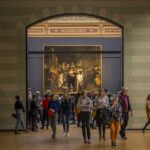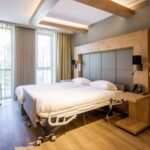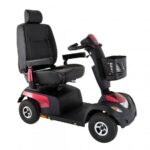The Netherlands is a country steeped in history, and its castles are a testament to centuries of royal intrigue, military strategy, and architectural brilliance. From medieval fortresses to grand country estates, Dutch castles have played pivotal roles in shaping the nation’s past. Many of these iconic landmarks are nestled in picturesque landscapes, offering visitors a unique opportunity to step back in time while exploring the country’s rich cultural heritage.
In this guide, we’ll take you through some of the most accessible castles to visit in the Netherlands. Whether you’re interested in exploring the imposing walls of ancient strongholds or strolling through the beautiful gardens of stately manors, these castles are committed to ensuring that all visitors—regardless of mobility needs—can fully enjoy their historical and architectural wonders. We’ll highlight wheelchair access, sensory accommodations, and other helpful features to make your visit as comfortable and enriching as possible.
The Netherlands is home to over 300 castles and fortified palaces, many of which are open to the public. While not all of these historic sites are fully wheelchair accessible, most feature stunning gardens that can be easily explored by visitors with mobility challenges. Additionally, some of these royal residences offer interior access for wheelchair users, allowing everyone to experience the beauty and history of these magnificent buildings.
Accessible Castle Visits in the Netherlands
Soestdijk Palace
Soestdijk Palace is a former palace of the Dutch Royal Family and it is located on the border of Baarn. The royal building consists of a central block and two wings. It was the official residence of Princess Juliana and Prince Bernhard, former queen and king of the Netherlands until 2004. It was uninhabited for more than a year when it opened for the public in 2006.
The tour takes the visitors through the representative style rooms and the private quarters of the former queen and king. The original atmosphere of the castle is very well preserved. The building is authentic and since it was inhabited for almost seventy years, it is a vulnerable part of the Dutch cultural heritage.
Accessibility Soestdijk Palace
The palace and the park are accessible for wheelchair users. There are several disabled parking spots available. The palace and the main route through the paved paths are accessible for visitors with a wheelchair or rollator. The size of the elevator is 90×120; therefore the wheelchair size must be the same size or smaller for visiting the palace. There is an accessible toilet in the Orangery and in the palace.
It is possible to rent a wheelchair or a walker at the cashier or at the entrance of Palace Soestdijk. However, reservation in advance is not possible.
Loevestein Castle
The castle was built by a knight called Diederic Loef of Horne in the Dutch countryside where two rivers meet. That time it was a good location to levy customs. Nowadays, it is a meeting point with friends, family or colleagues for a day out. The castle is also available for parties, meetings, weddings and it is possible to spend the night. There is a museum that belongs to the castle where visitors can learn virtually about the Middle Ages and the Hollandic Water Line.
Accessibility Loevenstein Castle
The fortress, powder tower and the exhibition in the soldiers’ houses are accessible to the disabled. Due to its medieval construction, the castle itself is unfortunately not accessible to wheelchair users and is difficult to access for people with mobility impairments.
Visitors with a disability are allowed to drive all the way into the fort. Visit the website of the castle!
Het Loo Palace
The palace is located just outside Apeldoorn. It was a residence of the Oranges, a royal family that played a central role in the politics of the Netherlands and had significant importance in Europe in the 17th century. The building went through renovation and is open for the public since 1984. The original furniture, object and paintings of the Oranges can be seen by the visitors. The palace is a national heritage site and one of the most visited museums in the Netherlands. The gardens that belong to the building are unique in the country with their symmetrical design.
Accessibility Het Loo Palace
The distances in the grounds of the palace are notable. It is advised to take plenty of time for the visit and to pick a quiet day. The quietest days are Tuesdays and Fridays and mornings are the calmest periods.
Since the walk is quite long -8 minutes- from the entrance building to the palace, golf cart transport is offered that are wheelchair- and walker accessible. The return ticket is €1 per person and there is room for eight people.
Het Loo Palace is wheelchair and walker accessible, but not wheelchair-friendly due to the limitations of the building and the gravel paths in the gardens. The whole interior can be visited except the upper floor of the East Wing and the Chapel. The corridors of the palace are narrow, wheelchairs with a width of 76 cm or smaller can access. The two elevators in the main building have 208 cm height, 140 cm depth and 89 width. Adapted toilets and parking for visitors with a disability are available as well. Guide dogs are allowed. Wheelchairs can be rented at the ticket office, but reservations cannot be made in advance. Companions from care institutions can enter free of charge if this is noted via info@paleishetloo.nl at least 3 working days prior to the visit. To have a complete overview of the accessibility and lift measurements we suggest to visit their page, by clicking here.
Beside the palace, the temporary exhibitions, the restaurants and the film theatre are accessible. The film theatre can accommodate up to 10 wheelchair-users.
Visitors with a disability are unable to join the regular guided tours outdoors, however, they can listen a guide who tells the story at a fixed point in the gardens. Visit the website of the palace!
Hoensbroek Castle
Hoensbroek Castle can be found in the south part of the Netherlands in Limburg province and is one of the largest and most stunning castles in the country. It consists of 40 different beautiful halls and rooms and the oldest structure of the castle is dates from 1250. Visitors can view the ballroom, the spooky dungeon and enjoy the view from 60 m height in the medieval look-out tower.
The castle complex is surrounded by a moat and a bridge arches over the water that leads to the main building. Two identical towers are situated at the main building and the forecastles enclose two large inner courts.
Hoensbroek Castle was inhabited through seven centuries. It has been residence for medieval knights, earls and rich men. Even though not everyone had the same prominent role, all these noble people filled high political functions, married in their own circle, grabbed land and titles. There are several stories around the castle that were carried by word of mouth and sometime got exaggerated to a more imaginative version. Found out more about these legends during your visit!
Accessibility Hoensbroek Castle
The castle is mostly accessible for wheelchair-users and elevator is available in the building. Parking space for people with a disability is available within 50 meters from the castle, free of charge. People with a disability and one companion can purchase entrance ticket for a reduced price. Visit the website of the castle!
About the author

Silvia Causin is a passionate expert in accessible travel, committed to making travel more inclusive for everyone. She shares valuable insights on how to navigate the world with ease, comfort, and confidence.
Would you like to enhance your trip to the Netherlands?
Enhance your trip to the Netherlands with our tailored services! From accessible tours and mobility equipment rentals to convenient hotel bookings, we cater to all your travel needs. Experience the beauty and culture of the Netherlands with options designed for your comfort and accessibility. Explore our offerings today and make the most of your visit!

Experience the best of the Netherlands with our thoughtfully designed accessible tours. Enjoy cultural attractions, scenic sights, and guided explorations that cater to your mobility needs, ensuring an enriching experience for everyone.

Find the perfect accommodation with our hotel booking service. We offer a selection of accessible hotels that prioritize your comfort, ensuring a restful stay as you explore the beauty of the Netherlands.

Make your journey easier with our mobility equipment rental service. From wheelchairs to scooters, we provide high-quality equipment to help you navigate the Netherlands comfortably and confidently.
